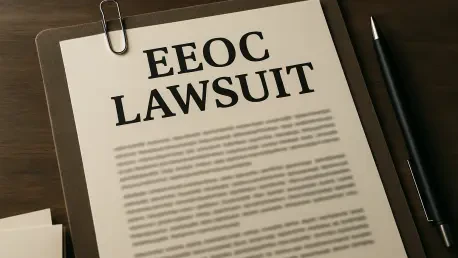Imagine a workplace discrimination claim filed with high hopes of swift justice, only to be derailed by a procedural misstep that could have been avoided. This scenario is becoming increasingly relevant as federal courts grapple with the U.S. Equal Employment Opportunity Commission’s (EEOC) practice of issuing early Notices of Right to Sue (NRTS). A recent landmark ruling in a New York federal court has cast doubt on the legality of such actions, spotlighting a rift in judicial interpretations across the country. This report delves into the intricate balance between administrative efficiency and statutory compliance in employment discrimination law, exploring how this issue affects employees, employers, and the broader legal landscape. By examining key cases and emerging trends, the discussion aims to shed light on a critical challenge facing the industry today.
Understanding the EEOC’s Role in Discrimination Claims
The EEOC stands as a cornerstone of workplace fairness in the United States, tasked with enforcing federal laws against discrimination based on race, sex, age, disability, and other protected characteristics. Established to mediate and investigate claims, the agency serves as a vital intermediary between employees alleging unfair treatment and employers defending their practices. Its mission is to ensure that allegations are addressed before escalating to costly and time-consuming litigation, fostering resolutions through conciliation when possible.
A pivotal element of the EEOC’s process is the issuance of a Notice of Right to Sue, which allows an employee to pursue a federal lawsuit if the agency cannot resolve the claim. This procedural step is not merely a formality; it signifies that the EEOC has either completed its investigation or determined that further inquiry within its timeframe is unfeasible. The significance of this notice lies in its gatekeeping function, ensuring that only thoroughly vetted claims proceed to court, thus protecting all parties from premature legal battles.
Beyond individual cases, the EEOC operates within a complex web of employment law involving federal regulations and diverse stakeholders. Employees seek timely redress, employers demand fair scrutiny of claims, and the agency itself must navigate resource constraints while upholding justice. This dynamic underscores the importance of clear procedural guidelines, as inconsistencies can lead to legal uncertainty and undermine trust in the system.
Legal Framework and the 180-Day Investigation Requirement
Statutory Obligations of the EEOC
Under federal law, specifically Title VII of the Civil Rights Act of 1964, the EEOC is mandated to investigate discrimination claims for a minimum of 180 days before issuing an NRTS. This timeframe is designed to provide ample opportunity for a detailed examination of the allegations, allowing the agency to gather evidence, interview parties, and potentially broker a settlement. The requirement reflects a legislative intent to prioritize resolution over rushed litigation, ensuring that claims are substantiated or dismissed based on merit.
This 180-day period serves as a buffer, safeguarding employers from unfounded lawsuits while giving employees a structured path to justice. By enforcing this timeline, Congress aimed to balance the need for thoroughness with the practical realities of administrative workload, recognizing that premature lawsuits could strain judicial resources. The rule stands as a critical checkpoint in the discrimination claim process, shaping how cases transition from agency oversight to courtroom battles.
Judicial Interpretations Across Circuits
Historically, federal circuits such as the Second, Ninth, and Eleventh have leaned toward granting the EEOC discretion in issuing early NRTS letters, particularly when investigations are unlikely to conclude within the mandated period. These courts have often viewed the 180-day rule as a flexible guideline, prioritizing administrative efficiency and employee access to timely legal recourse. Such rulings have allowed the agency to manage its caseload by expediting certain claims to court when appropriate.
However, a contrasting perspective is emerging, with some courts advocating for strict adherence to the statutory timeline. This divergence in judicial thought has created a patchwork of legal standards across regions, fueling debates over whether the EEOC’s discretion undermines the law’s intent. As these differing interpretations collide, they lay the groundwork for significant legal contention, with implications for how discrimination claims are processed nationwide.
The Prichard Case: A Turning Point in EEOC Procedure
In a groundbreaking decision in the Eastern District of New York, the federal court in Cecilia Prichard v. Long Island University challenged the EEOC’s authority to issue an NRTS before the 180-day investigation period elapsed. The case centered on a disability discrimination claim where the agency issued the notice after just 57 days, citing an inability to complete its review within the required timeframe. This action prompted scrutiny over whether such early issuance aligned with statutory mandates.
The court ruled that the premature NRTS was invalid, asserting that the EEOC overstepped its authority by sidestepping the full investigation period. Consequently, the plaintiff’s lawsuit was dismissed, highlighting a strict interpretation of the law that prioritizes procedural compliance over expediency. The decision marked a notable shift, emphasizing that the agency must fulfill its investigatory obligations before allowing claims to proceed to litigation.
This ruling diverges from the more lenient trends in other circuits, offering a protective shield to employers against lawsuits initiated too soon. By invalidating the early notice, the court underscored the importance of the EEOC’s role as a thorough gatekeeper, potentially reshaping how similar cases are handled in this jurisdiction. The implications of this precedent could resonate beyond New York, prompting a reevaluation of longstanding practices.
Challenges and Conflicts in EEOC Practices
The tension between administrative efficiency and statutory compliance lies at the heart of the EEOC’s operational challenges. On one hand, the agency faces pressure to process claims quickly, reducing backlogs and ensuring employees can seek justice without undue delay. On the other hand, bypassing the 180-day investigation risks undermining the thoroughness that the law demands, potentially leading to poorly vetted cases flooding the courts.
Balancing employee access to timely remedies with the need for comprehensive reviews presents a persistent dilemma. Jurisdictional discrepancies among federal circuits further complicate this issue, as varying interpretations of the 180-day rule create uncertainty for stakeholders navigating discrimination lawsuits. Employers in some regions may face early litigation, while those in others benefit from stricter procedural enforcement, highlighting an uneven legal landscape.
To address these conflicts, the EEOC could consider strategies such as improved case management systems or issuing clearer guidelines on NRTS issuance. Enhancing transparency around the criteria for early notices might help align practices with judicial expectations, reducing the risk of legal challenges. Such measures could foster consistency, ensuring that the agency upholds its mandate while adapting to diverse court rulings.
Regulatory and Legal Implications of the Prichard Ruling
The Prichard decision has sent ripples through EEOC policies, particularly within the Eastern District of New York, where adherence to the 180-day investigation period is now firmly reinforced. This ruling compels the agency to reevaluate its approach to early NRTS issuance, potentially leading to stricter internal protocols to prevent similar procedural errors. It serves as a reminder of the importance of compliance with statutory timelines in maintaining the integrity of the discrimination claim process.
For employers, this precedent offers a stronger defense against premature lawsuits, as courts may dismiss cases lacking a valid NRTS issued after the full investigation period. Employees, meanwhile, must adjust their strategies, ensuring they do not rush to court before the mandated timeframe elapses, or risk having their cases thrown out. This shift could influence how both parties approach the timing and filing of discrimination claims.
Looking broader, the Prichard ruling raises the possibility of Supreme Court intervention to resolve the circuit split on NRTS issuance. A definitive ruling from the highest court could standardize practices across the nation, eliminating regional disparities and providing clarity to the EEOC and stakeholders. Until such resolution occurs, the legal community will likely continue to monitor how this decision shapes agency behavior and litigation trends.
Future Outlook for EEOC Procedures and Discrimination Litigation
As the implications of the Prichard ruling unfold, long-term effects on EEOC practices and employment discrimination law are expected to emerge over the coming years. Courts may increasingly scrutinize the agency’s compliance with statutory mandates, pushing for greater accountability in how investigations are conducted and notices issued. This trend toward judicial oversight could redefine the balance between administrative flexibility and legal requirements.
Emerging patterns in case law suggest a growing emphasis on protecting the investigatory process, which might encourage legislative or regulatory reforms to address the 180-day debate. Adjustments to the timeframe or clearer definitions of when early NRTS issuance is permissible could help standardize procedures, reducing confusion for all involved parties. Staying abreast of these developments will be crucial for employers and employees navigating jurisdictional nuances.
The potential for broader policy changes looms on the horizon, with discussions around streamlining EEOC operations gaining traction. Whether through updated federal guidelines or a landmark Supreme Court decision, the next few years could bring significant clarity to this contentious issue. Stakeholders are advised to monitor legal updates closely, as shifts in precedent or regulation could fundamentally alter the landscape of discrimination litigation.
Conclusion: Navigating the Path Ahead
Reflecting on the insights gathered, the Prichard case served as a critical reminder of the importance of adhering to statutory timelines in EEOC processes. It highlighted a pivotal shift in how early NRTS issuance was perceived, challenging prior leniency and reinforcing the agency’s investigatory mandate. This decision underscored the need for a balanced approach that respected both procedural integrity and the rights of claimants.
Moving forward, stakeholders are encouraged to advocate for clearer guidelines from the EEOC, ensuring consistency in how discrimination claims progress to litigation. Collaborative efforts between legal experts, employers, and employee advocates could drive policy adjustments that address circuit splits and procedural ambiguities. By fostering dialogue on these issues, the employment law community can work toward a framework that upholds fairness while streamlining access to justice.









